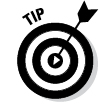Chapter 10
Shopping Made Easy
In This Chapter
 Getting comfortable with the verb “to buy”
Getting comfortable with the verb “to buy”
 Finding out where to buy stuff
Finding out where to buy stuff
 Looking for clothes
Looking for clothes
 Selecting the items you want and paying for them
Selecting the items you want and paying for them
 Checking out great Russian souvenirs to buy
Checking out great Russian souvenirs to buy
Russians love to hunt for nice, mostly Western-made, goods. Buying anything new, whether it’s a stereo, a sofa, or a coat, is a pleasant experience and an important event. So as an American (or other Westerner) shopping in Russian stores, you should feel right at home!
In this chapter, we help you find different kinds of stores, and we show you how to discover store hours and get assistance when you’re there. We also instruct you in the art of clothes-shopping, Russian-style. We show you how to get the right color and size, how to ask to try things on, and what to say when you want to compare different items. You also find out how to pay for your selections in a Russian store.
Shopping with Confidence: The Verb “To Buy”
|
Conjugation |
Pronunciation |
|
я покупаю |
ya pah-kooh-pah-yooh |
|
ты покупаешь |
ti pah-kooh-pah-eesh’ |
|
он/она покупает |
ohn/ah-nah pah-kooh-pah-eet |
|
мы покупаем |
mi pah-kooh-pah-eem |
|
вы покупаете |
vi pah-kooh-pah-ee-tee |
|
они покупают |
ah-nee pah-kooh-pah-yooht |
Like any Russian verb, this verb has two forms to choose from: imperfective and perfective. Your choice depends on the meaning you intend to express. The preceding conjugation, like all Russian verbs in the present tense, uses the imperfective form. Very often, however, you use “to buy” in the infinitive (dictionary) form, in sentences like I want to buy (a car, a couch, a parrot), in which case you need to use the perfective form: Я хочу купить (ya khah-chooh kooh-peet’) (I want to buy) followed by the name of the merchandise you want to buy in the accusative case (see Chapter 3 for more about cases).
To brag about your new purchase, you need the verb in the past tense, again in its perfective form (купить):
|
Conjugation |
Pronunciation |
|
Я купил |
ya kooh-peel (if you’re a man) |
|
Я купила |
ya kooh-pee-luh (if you’re a woman) |
|
Ты купил/купила |
ti kooh-peel/kooh-pee-luh |
|
Он купил |
ohn kooh-peel |
|
Она купила |
ah-nah kooh-pee-luh |
|
Мы/вы/они купили |
mi/vi/ah-nee kooh-pee-lee |
To promise somebody that you will buy something, use the verb in the future tense, again in its perfective form (купить):
|
Conjugation |
Pronounciation |
|
я куплю |
ya kooh-plyooh |
|
ты купишь |
ti kooh-peesh’ |
|
он/она купит |
ohn/ah-nah kooh-peet |
|
мы купим |
mi kooh-peem |
|
вы купите |
vi kooh-pee-tee |
|
они купят |
ah-nee kooh-pyeht |
So Many Stores, So Little Time: The Shopping Scene in Russia
In the grand scheme of things, Russian stores aren’t too different from those in the United States. In the following sections, we describe many different kinds of stores and merchandise, as well as how to find a store’s hours, navigate a store with ease, and accept (or decline) assistance.
Looking at different types of stores and merchandise
Stores that sell anything other than food can be divided into two major categories:
 универмаги (ooh-nee-veer-mah-gee) (department stores)
универмаги (ooh-nee-veer-mah-gee) (department stores)
 Smaller, specialized магазины (muh-guh-zee-ni) (stores), which may specialize in anything from tableware to TVs.
Smaller, specialized магазины (muh-guh-zee-ni) (stores), which may specialize in anything from tableware to TVs.
Additionally, there are now multitudes of smaller, privately owned, specialized stores scattered all over cities. Whereas бутики sell mostly clothing, these smaller stores sell a variety of merchandise one may really need. Unfortunately, the secret of what these stores sell may often be hidden behind a fancy store name that has nothing to do with the merchandise the store offers — the only way to figure out what these stores actually sell is to go in and look around. The most efficient way to find a store you need is to use the Yellow Pages, which classify the stores into categories according to the goods they offer. Following are some typical classifications:
 аптека (uhp-tyeh-kuh) (pharmacy)
аптека (uhp-tyeh-kuh) (pharmacy)
 одежда (ah-dyehzh-duh) (clothes)
одежда (ah-dyehzh-duh) (clothes)
 мужская одежда (moohzh-skah-yeh ah-dyehzh-duh) (men’s apparel)
мужская одежда (moohzh-skah-yeh ah-dyehzh-duh) (men’s apparel)
 женская одежда (zhehn-skuh-yeh ah-dyehzh-duh) (women’s apparel)
женская одежда (zhehn-skuh-yeh ah-dyehzh-duh) (women’s apparel)
 бельё (beel’-yoh) (intimate apparel)
бельё (beel’-yoh) (intimate apparel)
 детская одежда (dyeht-skuh-yeh ah-dyehzh-duh) (children’s apparel)
детская одежда (dyeht-skuh-yeh ah-dyehzh-duh) (children’s apparel)
 верхняя одежда (vyehrkh-nee-yeh ah-dyehzh-duh) (outerwear)
верхняя одежда (vyehrkh-nee-yeh ah-dyehzh-duh) (outerwear)
 спортивные товары (spahr-teev-ni-ee tah-vah-ri) (sports)
спортивные товары (spahr-teev-ni-ee tah-vah-ri) (sports)
 музыкальные товары (mooh-zi-kahl’-ni-ee tah-vah-ri) (music)
музыкальные товары (mooh-zi-kahl’-ni-ee tah-vah-ri) (music)
 фототовары (foh-tah-tah-vah-ri) (photography)
фототовары (foh-tah-tah-vah-ri) (photography)
 электротовары (eh-lyehk-trah-tah-vah-ri) (electrical goods)
электротовары (eh-lyehk-trah-tah-vah-ri) (electrical goods)
 галантерея (guh-luhn-tee-ryeh-yeh) (haberdashery)
галантерея (guh-luhn-tee-ryeh-yeh) (haberdashery)
 головные уборы (gah-lahv-ni-ee ooh-boh-ri) (hats)
головные уборы (gah-lahv-ni-ee ooh-boh-ri) (hats)
 косметика (kahs-myeh-tee-kuh) (makeup)
косметика (kahs-myeh-tee-kuh) (makeup)
 парфюмерия (puhr-fyooh-myeh-ree-yeh) (perfume)
парфюмерия (puhr-fyooh-myeh-ree-yeh) (perfume)
 ювелирные товары (yooh-vee-leer-ni-ee tah-vah-ri) (jewelry)
ювелирные товары (yooh-vee-leer-ni-ee tah-vah-ri) (jewelry)
 газетный киоск (guh-zyeht-niy kee-ohsk) (newsstand)
газетный киоск (guh-zyeht-niy kee-ohsk) (newsstand)
 канцелярские товары (kuhn-tsi-lyar-skee-ee tah-vah-ri) (stationery products)
канцелярские товары (kuhn-tsi-lyar-skee-ee tah-vah-ri) (stationery products)
 хозяйственные товары (khah-zyay-stvee-ni-ee tah-vah-ri) (household goods or hardware)
хозяйственные товары (khah-zyay-stvee-ni-ee tah-vah-ri) (household goods or hardware)
 кухонные товары (kooh-khah-ni-ee tah-vah-ri) (kitchen and tableware)
кухонные товары (kooh-khah-ni-ee tah-vah-ri) (kitchen and tableware)
 ткани (tkah-nee) (fabric)
ткани (tkah-nee) (fabric)
 цветы (tsvee-ti) (flowers)
цветы (tsvee-ti) (flowers)
 антикварные магазины (uhn-tee-kvahr-niy muh-guh-zeen’) (antique store)
антикварные магазины (uhn-tee-kvahr-niy muh-guh-zeen’) (antique store)
 коммиссионный магазин (kah-mee-see-ohn-iy muh-guh-zeen ) (secondhand store)
коммиссионный магазин (kah-mee-see-ohn-iy muh-guh-zeen ) (secondhand store)
 сувениры (soo-vee-nee-ri) (souvenirs)
сувениры (soo-vee-nee-ri) (souvenirs)
Finding out when a store is open
The easiest way to find out whether a Russian store is open is to go there and look for a sign on the door that indicates the days and times when the store is open. You may see something like this:
Часы работы (chuh-si ruh-boh-ti) (hours of work)
понедельник–пятница 10–18 (pah-nee-dyehl’-neek pyat-nee-tsuh s dee-see-tee dah vah-seem-naht-suh-tee) (Monday through Friday, 10 a.m. to 6 p.m.)
суббота, воскресенье 11–16 (sooh-boh-tuh, vahs-kree-syehn’-ee s ah-dee-nuht-suh-tee dah shis-naht-suh-tee) (Saturday, Sunday, 11 a.m. to 4 p.m.)
Another way to find out whether a store is open is just to call. If nobody answers the phone, the store is probably closed. Problem solved! But if someone does answer, you may want to ask one of these questions:
Магазин открыт? (muh-guh-zeen aht-krit?) (Is the store open?)
До какого часа открыт магазин? (duh kuh-koh-vah chah-suh aht-krit muh-guh-zeen?) (’Til what time is the store open?)
You may hear these (quite abrupt) responses:
Да, открыт. (dah, aht-krit.) (Yes, it is.)
До шести. (dah-shis-tee.) (’Til six.)
Here’s an example of what to say if you want to inquire whether the store is open on a particular day:
В воскресенье магазин открыт? (v vahs-kree-syehn’-ee muh-guh-zeen aht-krit?) (Is the store open on Sunday?)
Note that the word indicating the day should be in the accusative case.
In response, you’ll probably hear:
Нет, закрыт. (nyeht, zuh-krit.) (No, it’s closed.)
Some other ways to ask about store hours include the following:
Когда магазин закрывается? (kahg-dah muh-guh-zeen zuh-kri-vah-eet-syeh?) (When does the store close?)
Когда завтра открывается магазин? (kahg-dah zahf-truh aht-kri-vah-eet-syeh muh-guh-zeen?) (When does the store open tomorrow?)
And in response to these questions you’ll hear something along the lines of В семь (v syehm’) (At seven).
Navigating a department store
Today’s Russian department stores are quite easy to navigate, especially if you refer to the list of goods we provide in the earlier section “Looking at different types of stores and merchandise.” The signs indicating what’s for sale are located exactly where you expect them to be: between the aisles.
If you feel lost, try to grab somebody who’s wearing a store uniform and quickly ask him where to find what you’re looking for. Here’s an example:
Где сувениры? (gdyeh sooh-vee-nee-ri?) (Where are souvenirs?)
The word indicating the merchandise should be used in its dictionary (nominative case) form. (See Chapter 3 for more information on cases.)
Another way to locate an item is to ask У вас продаются. . . ? (ooh vahs prah-duh-yooht-syeh. . . ?) (Do you sell. . . ?), inserting the name of the merchandise you’re looking for in the nominative case.

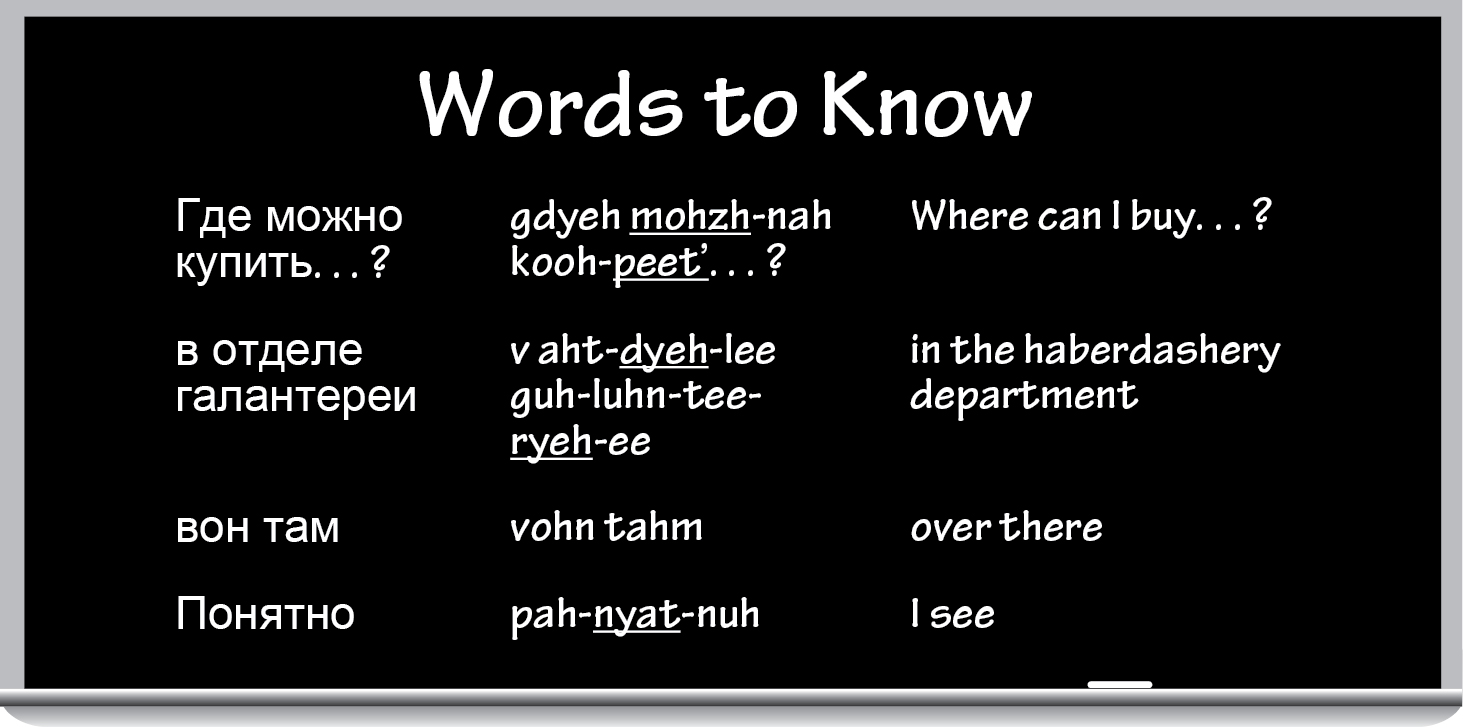
You Are What You Wear: Shopping for Clothes
Seeking specific items of clothing and accessories
We assume that if you indeed go to Russia, you’ll know what kind of weather to expect in different seasons and will bring the clothes and accessories that are appropriate for the time of the year. But what if you forget to pack a warm hat for winter or a pair of shorts for a hot Russian summer? (Yes, Russia gets warm weather, too.) Here we provide you with a list of words indicating some essential pieces of clothing you may find you left at home:
 пальто (puhl’-toh) (coat)
пальто (puhl’-toh) (coat)
 куртка (koohrt-kuh) (short coat or a warmer jacket)
куртка (koohrt-kuh) (short coat or a warmer jacket)
 плащ (plahsh’) (raincoat or trench coat)
плащ (plahsh’) (raincoat or trench coat)
 сандалии (suhn-dah-lee-ee) (sandals)
сандалии (suhn-dah-lee-ee) (sandals)
 кроссовки (krah-sohf-kee) (sneakers)
кроссовки (krah-sohf-kee) (sneakers)
 сапоги (suh-pah-gee) (boots)
сапоги (suh-pah-gee) (boots)
 туфли (toohf-lee) (lighter shoes for men and women)
туфли (toohf-lee) (lighter shoes for men and women)
Note: The term “lighter” includes dress shoes, casual shoes, high-heel shoes — anything but boots.
 рубашка (rooh-bahsh-kuh) (shirt)
рубашка (rooh-bahsh-kuh) (shirt)
 футболка (fooht-bohl-kuh) (football jersey or sports shirt)
футболка (fooht-bohl-kuh) (football jersey or sports shirt)
 блузка (bloohz-kuh) (blouse)
блузка (bloohz-kuh) (blouse)
 свитер (svee-tyehr) (sweater)
свитер (svee-tyehr) (sweater)
 кофта (kohf-tuh) (cardigan)
кофта (kohf-tuh) (cardigan)
 брюки (bryooh-kee) (pants)
брюки (bryooh-kee) (pants)
 джинсы (dzhin-si) (jeans)
джинсы (dzhin-si) (jeans)
 шорты (shohr-ti) (shorts)
шорты (shohr-ti) (shorts)
 платье (plaht’-ee) (dress)
платье (plaht’-ee) (dress)
 юбка (yoohp-kuh) (skirt)
юбка (yoohp-kuh) (skirt)
 костюм (kahs-tyoohm) (suit)
костюм (kahs-tyoohm) (suit)
 пиджак (peed-zhahk) (suit jacket)
пиджак (peed-zhahk) (suit jacket)
 галстук (gahl-stoohk) (necktie)
галстук (gahl-stoohk) (necktie)
 носки (nahs-kee) (socks)
носки (nahs-kee) (socks)
 колготки (kahl-goht-kee) (pantyhose)
колготки (kahl-goht-kee) (pantyhose)
 трусы (trooh-si) (men’s underwear)
трусы (trooh-si) (men’s underwear)
 женское бельё (zhehn-skah-ee beel’-yoh) (women’s underwear)
женское бельё (zhehn-skah-ee beel’-yoh) (women’s underwear)
 бюстгалтер (byoohst-gahl-tyehr) (bra)
бюстгалтер (byoohst-gahl-tyehr) (bra)
 пижама (pee-zhah-muh) (pajamas)
пижама (pee-zhah-muh) (pajamas)
 халат (khuh-laht) (robe)
халат (khuh-laht) (robe)
 купальник (kooh-pahl’-neek) (bathing suit)
купальник (kooh-pahl’-neek) (bathing suit)
 плавки (plahf-kee) (swimming trunks)
плавки (plahf-kee) (swimming trunks)
 кепка (kyehp-kuh) (cap)
кепка (kyehp-kuh) (cap)
 шляпа (shlya-puh) (hat)
шляпа (shlya-puh) (hat)
 шапка (shahp-kuh) (warm winter hat)
шапка (shahp-kuh) (warm winter hat)
 шарф (shahrf) (scarf)
шарф (shahrf) (scarf)
 платок (pluh-tohk) (head scarf)
платок (pluh-tohk) (head scarf)
 перчатки (peer-chaht-kee) (gloves)
перчатки (peer-chaht-kee) (gloves)
 платок (pluh-tohk) (handkerchief)
платок (pluh-tohk) (handkerchief)
 пояс (poh-ees) (belt)
пояс (poh-ees) (belt)
 сумка (soohm-kuh) (purse)
сумка (soohm-kuh) (purse)
 очки (ahch-kee) (eyeglasses)
очки (ahch-kee) (eyeglasses)
 зонтик (zohn-teek) (umbrella)
зонтик (zohn-teek) (umbrella)
Describing items in color
What’s your favorite цвет (tsvyeht) (color)? So that you can get the color you want, here’s a quick list of the most common colors:
 белый (byeh-liy) (white)
белый (byeh-liy) (white)
 чёрный (chyohr-niy) (black)
чёрный (chyohr-niy) (black)
 коричневый (kah-reech-nee-viy) (brown)
коричневый (kah-reech-nee-viy) (brown)
 серый (syeh-riy) (gray)
серый (syeh-riy) (gray)
 синий (see-neey) (blue)
синий (see-neey) (blue)
 голубой (gah-looh-bohy) (light blue)
голубой (gah-looh-bohy) (light blue)
 лиловый (lee-loh-viy) (purple)
лиловый (lee-loh-viy) (purple)
 красный (krahs-niy) (red)
красный (krahs-niy) (red)
 розовый (roh-zah-viy) (pink)
розовый (roh-zah-viy) (pink)
 оранжевый (ah-rahn-zhi-viy) (orange)
оранжевый (ah-rahn-zhi-viy) (orange)
 желтый (zhohl-tiy) (yellow)
желтый (zhohl-tiy) (yellow)
 зелёный (zee-lyoh-niy) (green)
зелёный (zee-lyoh-niy) (green)
If you want to ask for a different shade of a color, use these phrases:
A потемнее есть? (uh pah-teem-nyeh-ee yehst’?) (Do you have it in a darker shade?)
А посветлее есть? (uh pahs-veet-lyeh-ee yehst’?) (Do you have it in a lighter shade?)
Other words that may come in handy are одного цвета (ahd-nah-voh tsvyeh-tuh) (solid) and цветной (tsveet-nohy) (patterned).
Finding the right size
Sizes from different systems of measurement are often displayed on the items themselves. If you need to convert from inches to centimeters for an item of clothing (Russian sizes are given in centimeters), multiply the size in inches by 2.53 and you get the equivalent size in centimeters. But the best way to be certain something fits is to just try the item on!
Following are some words and phrases you may hear or say while searching for the right size:
 размер (ruhz-myehr) (size)
размер (ruhz-myehr) (size)
 Я ношу . . . размер (ya nah-shooh . . . ruhz-myehr) (I wear size . . .)
Я ношу . . . размер (ya nah-shooh . . . ruhz-myehr) (I wear size . . .)
To indicate your size, use an ordinal number before the word размер (see Chapter 5 for more about numbers).
 Это мой размер. (eh-tah mohy ruhz-myehr.) (This is my size.)
Это мой размер. (eh-tah mohy ruhz-myehr.) (This is my size.)
 Какой у вас размер? (kuh-kohy ooh vahs ruhz-myehr?) (What’s your size?)
Какой у вас размер? (kuh-kohy ooh vahs ruhz-myehr?) (What’s your size?)
Trying on clothing
Before you decide to buy something, you probably want to try it on first. To ask to try something on, say
Можно померить? (mohzh-nuh pah-myeh-reet’?) (May I try this on?)
You’ll most likely hear
Да, пожалуйста. (dah, pah-zhahl-stuh.) (Yes, please.)
Then, you may ask where the dressing room is:
Где примерочная? (gdeh pree-myeh-rahch-nuh-yeh?) (Where is the fitting room?)
Here are some adjectives you may use to describe clothing:
 хороший (khah-roh-shiy) (good)
хороший (khah-roh-shiy) (good)
 плохой (plah-khohy) (bad)
плохой (plah-khohy) (bad)
 большой (bahl’-shohy) (big)
большой (bahl’-shohy) (big)
 маленький (mah-leen’-keey) (small)
маленький (mah-leen’-keey) (small)
 длинный (dlee-niy) (long)
длинный (dlee-niy) (long)
 короткий (kah-roht-keey) (short)
короткий (kah-roht-keey) (short)
When you’re done trying on and you walk out of the dressing room, the sales assistant may ask:
Ну, как? Подошло? (nooh, kahk? pah-dahsh-loh?) (Well? Did it fit?)
You can give either of the following responses:
Нет, спасибо. (nyeht, spuh-see-bah.) (No, thank you.)
Я хочу купить это. (ya khah-chooh kooh-peet’ eh-tah.) (I want to buy it.)
This or That? Deciding What You Want
One of the most exciting things about shopping for clothes (or anything, for that matter) is talking about the advantages and disadvantages of your potential purchase. In this section we give you all the words, phrases, and grammatical constructions you need to do just that. We tell you how to compare items and specify which one you like best. (Check out Chapter 6 if you need a refresher on how to express likes and dislikes.)
Using demonstrative pronouns
 этот (eh-taht) (this or this one) for masculine nouns
этот (eh-taht) (this or this one) for masculine nouns
 эта (eh-tuh) (this or this one) for feminine nouns
эта (eh-tuh) (this or this one) for feminine nouns
 это (eh-tah) (this or this one) for neuter nouns
это (eh-tah) (this or this one) for neuter nouns
 эти (eh-tee) (these or these ones) for plural nouns
эти (eh-tee) (these or these ones) for plural nouns
 тот (toht) (that or that one) for masculine nouns
тот (toht) (that or that one) for masculine nouns
 та (tah) (that or that one) for feminine nouns
та (tah) (that or that one) for feminine nouns
 то (toh) (that or that one) for neuter nouns
то (toh) (that or that one) for neuter nouns
 те (tyeh) (those or those ones) for plural nouns
те (tyeh) (those or those ones) for plural nouns
Using these words, you can say something like this:
Это платье лучше чем то. (eh-tah plaht’-yeh loohch-sheh chyehm toh.) (This dress is better than that one.)
Flip to Chapter 3 for full details on masculine, feminine, neuter, and plural nouns and pronouns.
Comparing two items
To compare things, Russian uses adjectives that express comparative degrees. Here is the list of those that may be used in reference to clothing:
 больше (bohl’-shi) (bigger)
больше (bohl’-shi) (bigger)
 меньше (myehn’-shi) (smaller)
меньше (myehn’-shi) (smaller)
 лучше (loohch-shi) (better)
лучше (loohch-shi) (better)
 хуже (khooh-zhi) (worse)
хуже (khooh-zhi) (worse)
 длиннее (dlee-nyeh-ee) (longer)
длиннее (dlee-nyeh-ee) (longer)
 короче (kah-roh-chee) (shorter)
короче (kah-roh-chee) (shorter)
 дороже (dah-roh-zheh) (more expensive)
дороже (dah-roh-zheh) (more expensive)
 дешевле (dee-shehv-lyeh) (cheaper)
дешевле (dee-shehv-lyeh) (cheaper)
 красивее (kruh-see-vee-ee) (more beautiful)
красивее (kruh-see-vee-ee) (more beautiful)
 удобнее (ooh-dohb-nee-ee) (more comfortable)
удобнее (ooh-dohb-nee-ee) (more comfortable)
 толще (tohl-sh’ee) (thicker)
толще (tohl-sh’ee) (thicker)
 тоньше (tohn’-shi) (thinner)
тоньше (tohn’-shi) (thinner)
 тяжелее (tee-zhi-lyeh-ee) (heavier)
тяжелее (tee-zhi-lyeh-ee) (heavier)
 легче (lyehk-chee) (lighter)
легче (lyehk-chee) (lighter)
Just as in English, the equation for creating a comparative sentence looks like this: the name of the item + the comparative adjective (for instance, “bigger” or “smaller”) + the word чем (chyehm) (than) + the other item. Say you’re trying on two pairs of shoes. You like the second pair better: It’s not only more comfortable but cheaper too. You may be thinking the following to yourself (in Russian!):
Эти туфли удобнее и дешевле чем те. (eh-tee toohf-lee ooh-dohb-nee-ee ee dee-shyehv-lee chyehm tyeh.) (These shoes are more comfortable and cheaper than those.)
The noun туфли should be in the nominative case.
Talking about what you like most (or least)
When you look at several items (or people or things), you may like one of them best of all. To communicate this preference, you may use the phrase Больше всего мне нравится . . . (bohl’-sheh fsee-voh mnyeh nrah-veet-syeh . . .) (I like . . . best of all), replacing the ellipsis with the one you like best. Another way to do it is to place the object of liking at the very beginning of the sentence:
Этот сувенир мне нравится больше всего. (eh-toht sooh-vee-neer mnyeh nrah-veet-syeh bohl’-sheh fsee-voh.) (I like this souvenir best of all.)
If you feel the urge to use the words “most” or “least” to express your emotions about a pending purchase, you should know that Russian uses the adjective самый (sah-miy) for both. Because it is an adjective, it should agree with the noun it’s used with in gender and number. So, for example, if, after trying a dozen dresses, you conclude, This is the most beautiful dress, in Russian you say Это самое красивое платье (eh-tah sah-mah-ee krah-see-vah-ee plaht’-ee).
You Gotta Pay to Play: Buying Items
After you decide on an item of clothing or any other piece of merchandise, you want to make sure the price is right. In the following sections, we show you how to ask how much something costs, how to indicate that you’ll take it, and how to find out how to pay for it.
How much does it cost?
If you’re buying one item and you want to find out how much it costs, use the phrase Сколько стоит. . . ? (skohl’-kah stoh-eet. . . ?) (How much does . . . cost?), inserting the name of the item in the nominative case. If you want to know the price of an umbrella, for example, ask:
Сколько стоит этот зонтик? (skohl’-kah stoh-eet eh-taht zohn-teek?) (How much is this umbrella?)
Note the order of words in this Russian question: It begins with “How much costs” and ends with the merchandise you’re interested in.
If you’re buying more than one of an item, ask Сколько стоят . . .? (skohl’-kah stoh-yeht. . . ?) (How much do . . . cost?), adding the name of the item in the nominative plural. For example, if you want to know the price of several umbrellas, you ask
Сколько стоят эти зонтики? (skohl’-kah stoh-yat eh-tee zohn-tee-kee?) (How much do these umbrellas cost?)
I’ll take it! How do I pay?
The simplest way to express your intention to buy something is to say
Я возьму это. (ya vahz’-mooh eh-tuh.) (I’ll take it.)
You can also use a form of the verb купить (kooh-peet’) (to buy):
Я это куплю. (ya eh-tuh kooh-plyooh.) (I’ll buy it.)
If you’re buying more than one item, say one of the following:
Я возьму их. (ya vahz’-mooh eekh.) (I’ll take them.)
Я их куплю. (ya eekh kooh-plyooh.) (I’ll buy them.)
The best way to pay for anything is certainly with a credit card. However, not all stores in Russia accept credit cards. If you’re unsure whether the store accepts credit cards, you can ask:
Вы принимаете кредитные карточки? (vi pree-nee-mah-ee-tee kree-deet-ni-ee kahr-tahch-kee?) (Do you accept credit cards?)
The answer will be similar to one of the following:
Да, принимаем. (dah, pree-nee-mah-eem.) (Yes, we do.)
Нет, не принимаем, только наличные. (nyeht, nee pree-nee-mah-eem, tohl’-kah nah-leech-ni-ee.) (No, we don’t, only cash.)
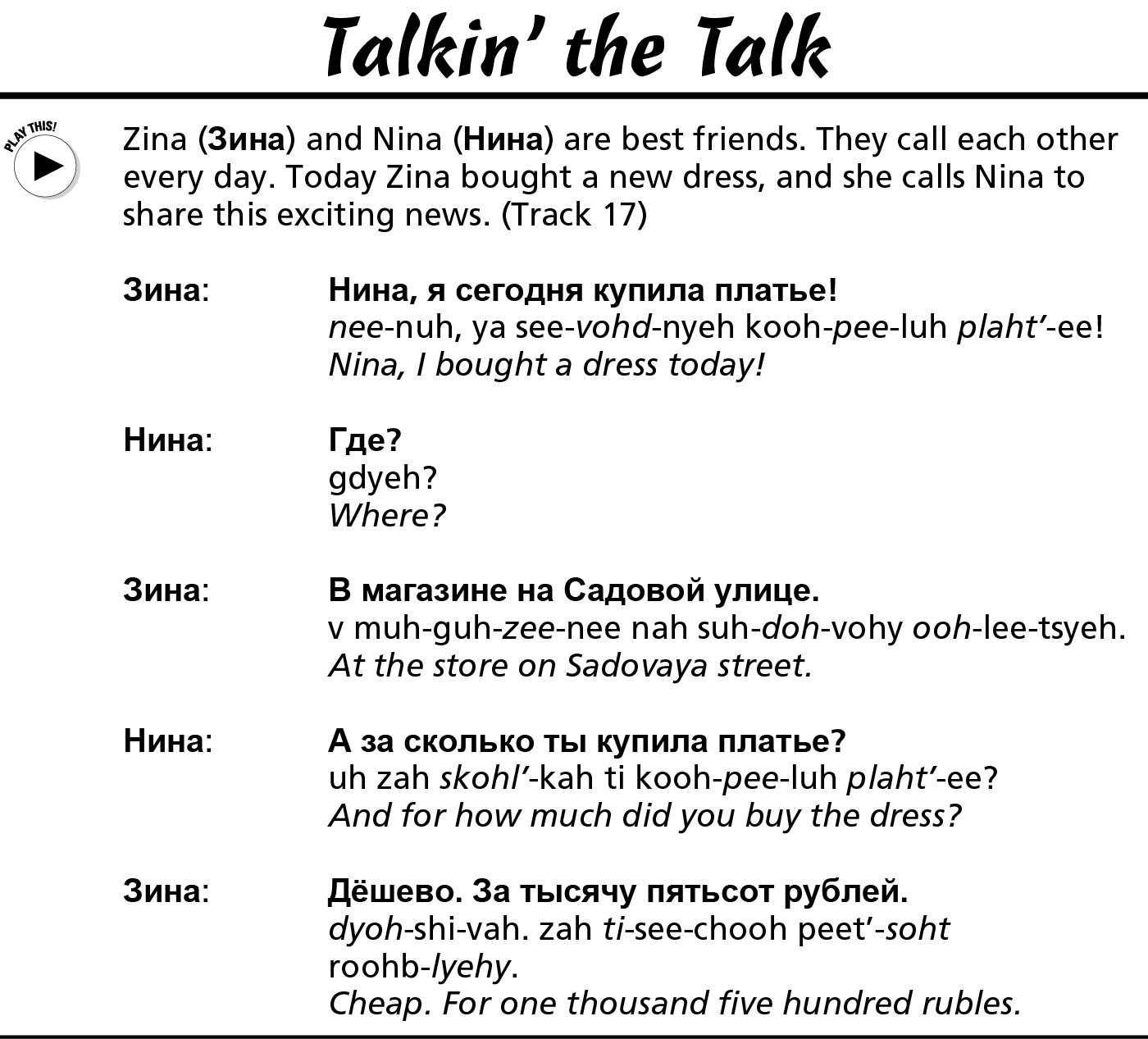
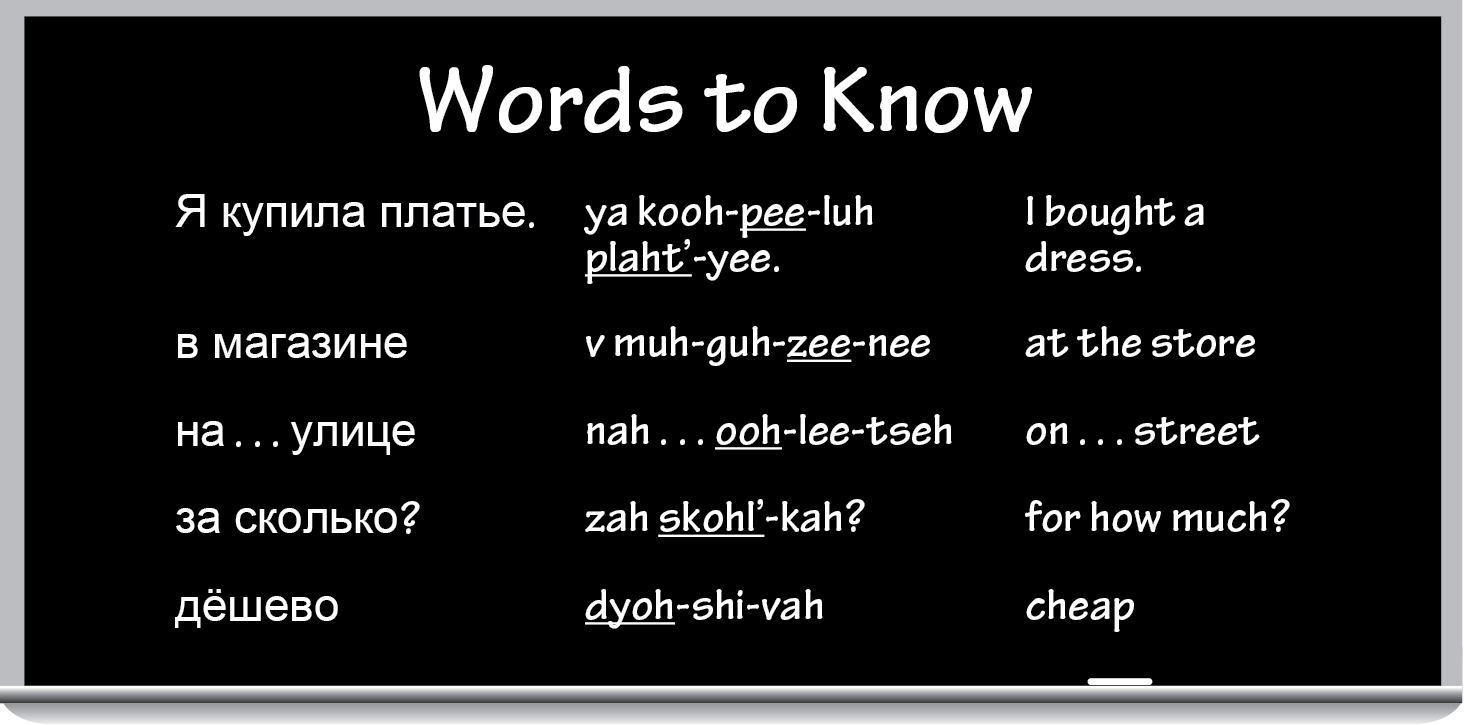
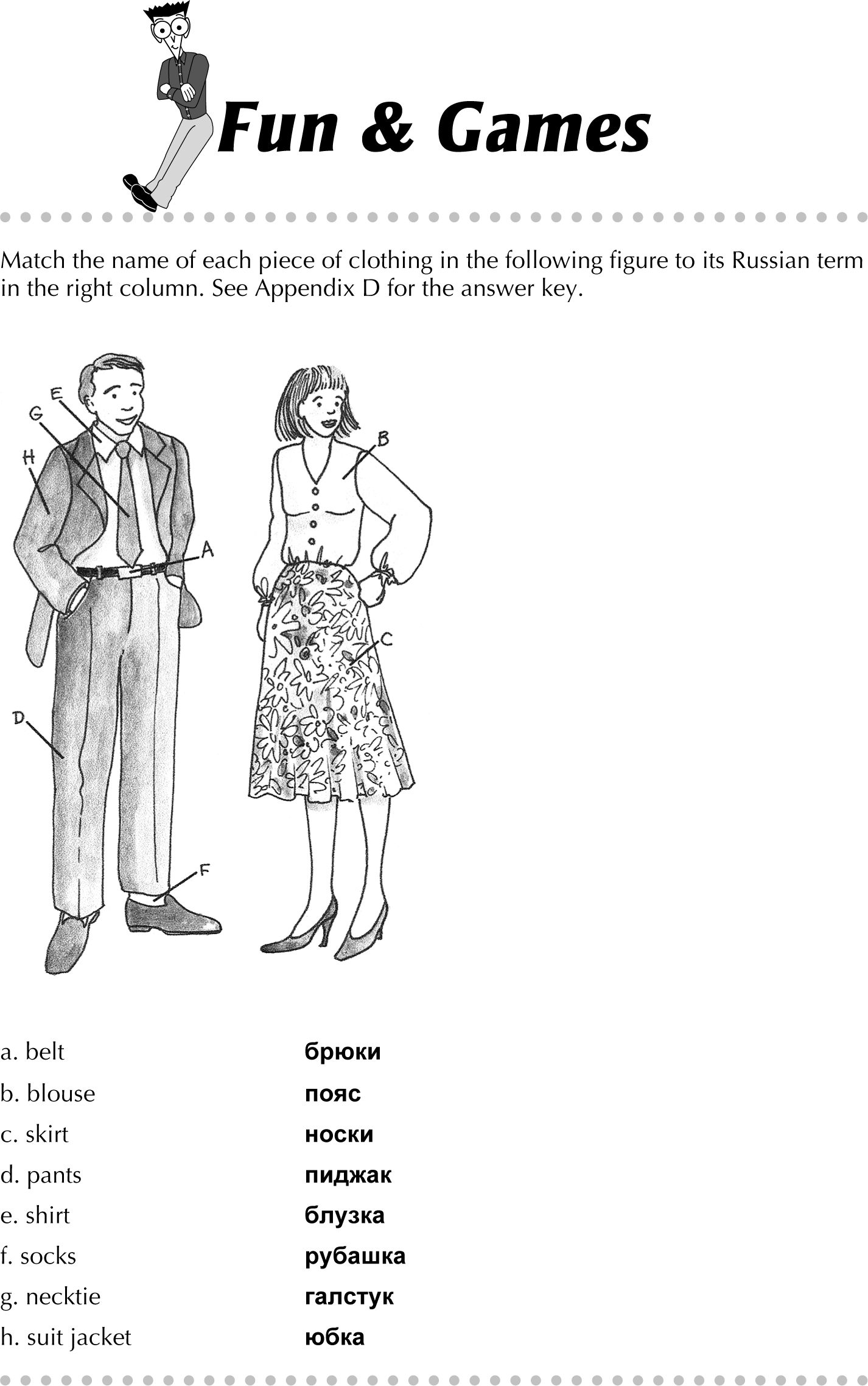
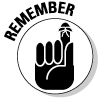
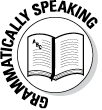 “Why should I use the perfective infinitive in this instance?” you may ask. Good question! Using the imperfective infinitive —
“Why should I use the perfective infinitive in this instance?” you may ask. Good question! Using the imperfective infinitive —  What used to be huge department stores in downtown Moscow and St. Petersburg have gradually turned into a collection of unbelievably expensive little boutique stores, also known as
What used to be huge department stores in downtown Moscow and St. Petersburg have gradually turned into a collection of unbelievably expensive little boutique stores, also known as 